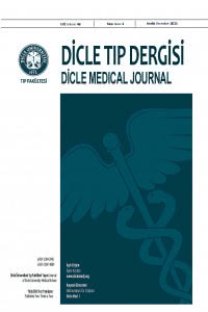Destruction of perineal skin and posterior bladder wall as a result of rectum adenocarcinoma’s invasion: A case report
Rektum adenokarsinomunun invazyonu sonucunda perineal cilt ve posterior mesane duvarı harabiyeti: Olgu sunumu
___
- 1. Kobayashi T, Kamoto T, Sugino Y, Takeuchi H, Habuchi T, Ogawa O. High incidence of urinary bladder involvement in carcinomas of the sigmoid and rectum: a retrospective review of 580 patients with colorectal carcinoma. J Surg Oncol 2003;84:209-14.
- 2. Moriya Y, Akasu T, Fujita S, Yamamoto S. Aggressive surgical treatment for patients with T4 rectal cancer. Colorectal Dis 2003;5:427-31
- 3. Moffat FL Jr, Falk RE. Radical surgery for extensive rectal cancer: is it worthwhile? Recent Results Cancer Res 1998;146:71-83.
- 4. Winter DC, Walsh R, Lee G, Kiely D, O’Riordain MG, O’Sullivan GC. Local involvement of the urinary bladder in primary colorectal cancer: outcome with en-bloc resection. Ann Surg Oncol 2007;14:69-73.
- 5. Galandiuk S, Jorden J, Mahid S, McCafferty MH, Tobin G. The use of tissue faps as an adjunct to pelvic surgery. Am J Surg 2005;190:186-90.
- 6. Wagner M, Vanderlee MG, Freeman J, Black ME. Transperineal resection of a retroperitoneal liposarcoma present- ing as a perineal mass. Obstet Gynecol 2005;105:1256-8.
- 7. Amorotti C, Mosca D, Pintaudi U, Maiorana A. Aggressive angiomyxoma of the pelvis and perineum: a case report and review of the literature. Chir Ital 2004;56:717-26.
- 8. Iannicelli E, Galluzzo A, Salvi PF, Ziparo V, David V. A large porocarcinoma of perineal region: MR fndings and review of the literature. Abdom Imaging 2008;33:744-7.
- 9. Ishii D, Irie A, Matsumoto K, et al. Laparoscopic radical cystectomy and bilateral ureteric ligation for muscle-invasive bladder cancer in a patient on hemodialysis. Int J Urol 2006;13:1009-11.
- ISSN: 1300-2945
- Yayın Aralığı: 4
- Başlangıç: 1963
- Yayıncı: Cahfer GÜLOĞLU
Akut piyelonefrit ile komplike bruselloz olgusu
Tüberküloz tarama amaçlı mikrofilm incelemesi yapan hekimlerin değerlendirme farklılıkları
Abdurrahman ABAKAY, Mehmet TOKSÖZ, Abdullah Çetin TANRIKULU, Özlem ABAKAY, Şenay EKİNCİ
MEHMET CANİKLİOĞLU, Mehmet Ali ERGÜL, Abdullah DEMİRTAŞ, Nurettin ŞAHİN, Oğuz EKMEKÇİOĞLU, İbrahim GÜLMEZ
The main histopathological gastric lesions in obese patients who underwent sleeve gastrectomy
Camelia Doina VRABIE, Manole COJOCARU, Maria VALLER, Ruxadra SINDELARU
Primary testicular lymphoma: A case report
CENGİZ DEMİR, Murat ATMACA, Eyüp TAŞDEMİR, Mustafa GÜNEŞ, Gülay BULUT
Miyokard perfüzyon sintigrafsi, eforlu EKG ve koroner anjiograf sonuçlarının karşılaştırılması
Zeki DOSTBİL, Habib ÇİL, Zuhal Arıtürk ATILGAN, Ebru TEKBAŞ, BUĞRA KAYA, Savaş SARIKAYA
Miyokard perfüzyon sintigrafisi, eforlu EKG ve koroner anjiografi sonuçlarının karşılaştırılması
Zeki DOSTBİL, Zuhal Arıtürk ATILGAN, Ebru TEKBAŞ, Buğra KAYA, Savaş KAYA, Habib ÇİL
İyonlaştırıcı radyasyonlar ve kanser
Evre II-III kolon kanserli hastalarda adjuvan tedavinin yan etki proflinin değerlendirilmesi
Kerim CAYIR, Mehmet BİLİCİ, Salim Başol TEKİN, Habip EMRE, YUSUF BİLEN
